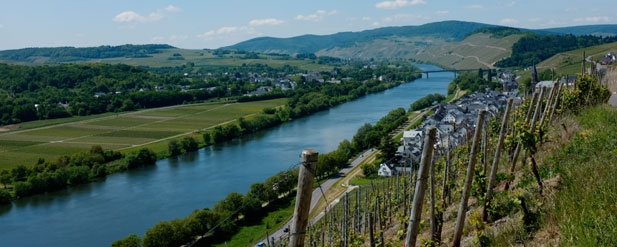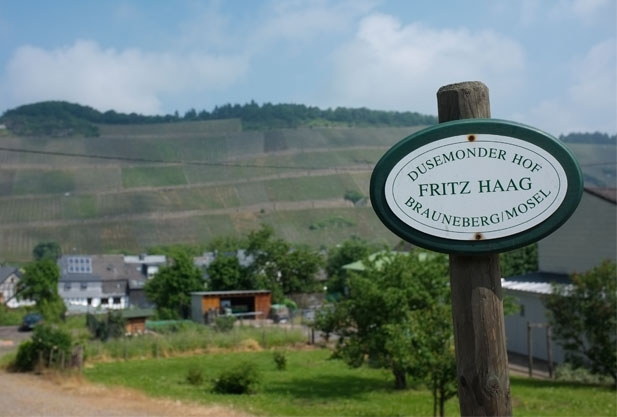
A charming surprise.
Selection, plenty of pickers, a fast harvest and good vineyard management were the keys to unlocking the potential of the 2014 vintage in Germany. The season started extremely well with many regions experiencing summer like conditions in the spring. For Andreas Spreitzer this precipitated the earliest flowering he’d ever seen, while Thomas Haag of Schloss Lieser described flowering as “perfect”. Fruit set across the regions was large and for the most part, even. By mid-June records were hinting at one of the warmest vintages on record. Many vines were even at in danger of experiencing drought stress.
This was all set to change as July and August proved to be unsettling for almost everyone, with large periods of rainfall and uneven weather delaying progress in the vineyards. Then September arrived and brought with it not just more rain but also some rather unwelcome humidity. Indeed, vines heavy with swelling bunches offer ample opportunity for the development of botrytis, and when warm weather is added into the equation the recipe is one that puts growers on edge.
This early sense of unease proved accurate as through September the rains continued to fall. Decisive action was needed if they were eventually to bring in healthy grapes, and this led many growers to invest huge amounts of time in their vineyards; green-harvesting bunches whose swollen and often touching grapes were starting to show signs of botrytis and uneven ripening. When harvest came, almost all growers reported enlisting many more pickers than usual. At Fritz Haag there were 45 people harvesting grapes, up from a norm of 20-25, at Donnhoff it was 55 up from 30 while Klaus-Peter Keller increased his picking staff from 15 to 25. Speed and extreme selection measures were of the essence. Most growers reported not only selecting out early strains of botrytis, but effectively carrying out brown harvests, dropping huge amounts of ripe but rotten fruit so as not to allow any unwanted forms of rot into the final blends. The final harvest times for many were some of their quickest ever, leading growers to dub 2014 the year of the “turbo harvest”.

As far as the finished wines are concerned, these weather patterns could potentially have been far more damaging. The early flowering and loaded fruit set meant that quality conscious growers could afford to drop anything substandard before it reached the winery, leaving the remaining grapes with a final hang-time of around 100 days, which is the norm. Christophe Schaeffer reported that they had full phenolic ripeness when the October rains came, but began to see falling acidity levels as a result of dilution. Others reported a similar situation with ripe grapes that were gaining nothing in terms of Oeschle (sugar) levels. The only option was to harvest. "The decision was very clear - harvest what you could that was healthy and in good shape," Renata von Schubert told us. Over in the Saar, Hano Zilliken’s old vines on the Rausch were perhaps the least affected by the rains. The cool Saar valley generally ripens later than other regions and as result the rains had less of a detrimental effect on their grapes, being as they were a week or two further away from harvest. Still, in the Saar alcohol levels are perhaps a degree or two lower than the norm, and the amount of nobly, shrivelled grapes that made it into the Rausch Auslese was markedly less than normal. At Emrich-Schoenleber, Frank calmly described harvest as “challenging, kind of hectic, we picked every Saturday and Sunday for a month with a lot of selecting out the early botrytis”. At Donnhoff the story was the same, with a large early September selection required to sort out unripe berries and bad rot and a harvest that eventually started two weeks earlier than normal (in line with flowering).
A note should be made about winter. One of the biggest problems facing many of these regions is the lack of intense and prolonged periods of cold over the past two winters. Neither 2013 nor 2014 produced the cold weather necessary to kill off vineyard pests such as the much talked about ‘drosophilia suzuki’. These ‘cherry vinegar flies’, recent arrivals from Asia, attack red grapes predominantly, and have the ability to puncture and lay eggs in the skins of ripe fruit at an alarming rate. It is possible to spray against them, but many such as August Kesseler would prefer not to as the sprays required have the unwanted side effect of killing off the local bee populations. It is not just red grapes that are under attack: At JJ Prum, they experienced problems with common vinegar flies at harvest, attracted by rot affected berries that were beginning to split, that forced them to start the harvest early if only to select out affected grapes. Cold hard winters need to return to nullify these pests.

So challenges to one side, what of the wines? In general they have classic levels of acidity, slightly lower than the extreme ‘13s, but very firmly at the crisp end of the spectrum. Alcohol levels are lower and general characteristics are lighter than the likes of ’06, ‘09 and ‘11. It was a rush to harvest for most, so generally there is a paucity of noble sweet wines showing overtly Botrytised characteristics. But there are many fine wines at the Kabinett to Auslese levels that have surprised almost everyone I spoke to for their charm and accessibility. Christopher Schaeffer puts 2014 in the racy category just like '13, though admits the two are very different. Wilhelm Haag described the vintage as “like those we had in the 1970s, lightness of touch, minerals and slate…maybe of recent vintages like an ‘08 or an ‘04”. Helmut Donnhoff described it as a “charming vintage” and went on, “it is perfect for the market, I like this style. I am looking for clean wines, not so opulent, indeed Riesling should be fine and clear and dancing. Not fat”. For the most part Kabinett and Spatlese wines are very successful, with excellent balance, poise and drinkability. Auslesen, those that have been made, are clear and pure, over and above the intensely sweet and botrytised style - all the better for drinking some might say. Dry wines, at the lower end of the spectrum pose more difficulties as the absence of balancing sugar renders some of them a little on the lean side, with minerality definitely to the fore. The Grosses Gewachs however show plenty of promise, the higher levels of ripeness and slightly lowered acidities coming together to produce wines of poise and grace and highly minerality characters, that should reveal their finest qualities in the near rather than the long term.
61 St. James's Street, London SW1A 1LZ
Reg. Company No: 68576
AWRS URN: XPAW00000105319
Please do not share with anyone under the legal purchase age for alcohol.
Drink Responsibly www.drinkiq.com
© Justerini & Brooks 2025. All Rights Reserved.